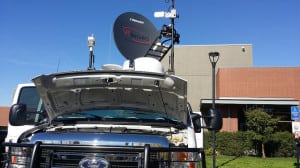Latest News
[Via Satellite 11-17-2014] The United States Department of Homeland Security (DHS) sees room for satellite to play a role in the First Responder Network Authority (FirstNet), a developing national broadband network prioritized for emergencies and public safety. Introduced in 2012 from the Middle Class Tax Relief and Job Creation Act, the U.S. government intends to provide interoperable communications services through FirstNet using nationwide 700 MHz spectrum. The law that created FirstNet demands that the network’s minimum technical requirements are based on the commercial standards for Long Term Evolution (LTE) service. Terrestrial connectivity will make up the majority of FirstNet, but mandates for connectivity in unreached places will likely necessitate that satellite play a role, according to Chris Alexander, Deputy Chief of Architecture and Advanced Technology Office of Emergency Communications (OEC), DHS.
Speaking at SATCON last week, Alexander described FirstNet as a future “fourth major cell phone provider,” following AT&T, Verizon and Sprint — the three networks he said are currently relied on the most for national responses. Once FirstNet is operational, DHS hopes to shift first responder traffic to the new network. Alexander said FirstNet should not be thought of as a terrestrial network because of congressional requirements to reach areas not covered by the three aforementioned telcos.
“If the LTE infrastructure takes up 90 percent, or covers 90 percent of the United States, that other 10 percent statistically may not be significant but strategically it could be tremendously significant. Who is going to cover that, and how are we going to get to that?” he said.
The U.S. Congress has allocated up to $7 billion to make sure all 50 states and six U.S. territories have a Radio Access Network (RAN) that taps into FirstNet’s core network. FirstNet is directed to seek ways to best use existing telecommunications infrastructure, including through public-private partnerships. Satellite industry companies have already begun evaluating what role they might play in FirstNet’s development.
“We are looking at FirstNet and what opportunity there is for satellite,” said Bryan Hill CEO of IP Access International, adding that while clients with command vehicles prefer 4G LTE when possible, it does not mean they refuse to use satellite. “They know that satellite will always be there no matter what happens, and they can’t say that about the other technologies.”
Globecomm Systems SVP and General Manager of Government Solutions Dwight Hunsicker, was uncertain regarding FirstNet’s potential for satellite, and said it will take more time to see how it evolves. He said Globecomm would initially look at other ways of getting involved.
“On the wireless side we see great opportunity helping the network operators beef up their networks and expand their footprint, [but] we at Globecomm aren’t going to go boil the ocean for FirstNet. Our customers will be the local operators,” he said.
DHS relies heavily on radio, telephony and broadband as the three technology fields for emergency communications. Alexander said voice remains the dominant form of communications, and that broadband is starting to play a larger role.
“Before Katrina only a couple of satellite dishes were [VOIP] enabled, but that became a major capability that we then leveraged. That’s all become standardized. As we move into more of a data rich environment, our users are starting to expect that too,” he said.
Alexander said satellite provides resiliency for terrestrial communications, and though often more expensive, can be advantageous from a cost perspective over building additional LTE towers and other terrestrial infrastructure in hard to reach places. Satellite can also help first responders relay information back to the government in emergencies before news outlets. In isolated environments or in disaster scenarios, satellite may be the only way to maintain voice, data and increasingly important video communications.
“We want the decision makers to see the video first. We don’t want to see it on CNN before our decision makers see it. That’s an unwritten goal of some of the federal first responders is get that information up to command so they have visuals. We are much more visually oriented now than we used to be,” said Alexander.
Get the latest Via Satellite news!
Subscribe Now